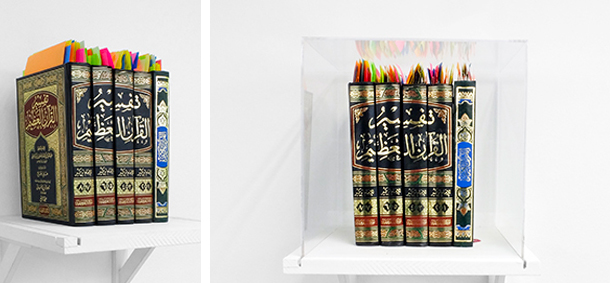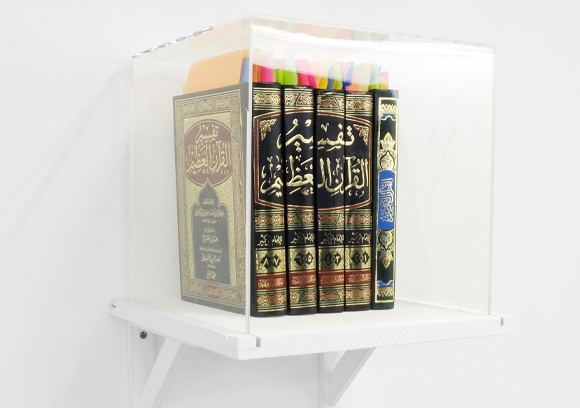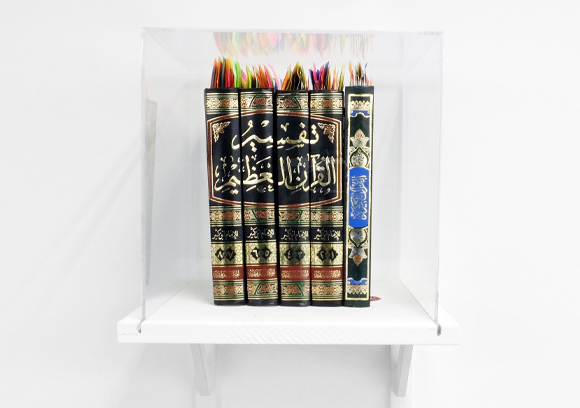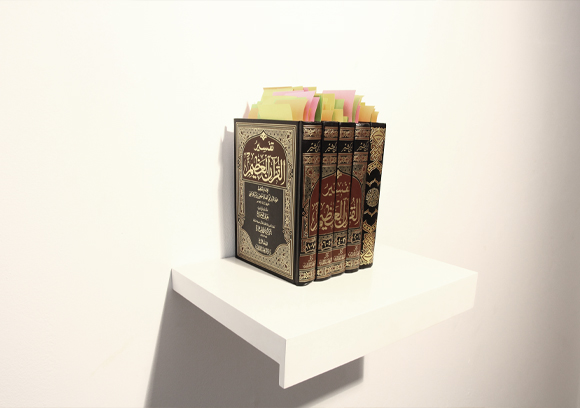| |
|
32.
 | I Want to Understand 03
| I Want to Understand 03 |
| |

'' By removing the text from its religious context and placing it in a museum, which is to say in a context of observation and critical thought, the words of the creator are confronted with public debate. ''
Studio Fatmi, April 2017

I Want to Understand 03
Exhibition view from Art Brussels, ADN Gallery, 2017, Brussels.

I Want to Understand 03
Exhibition view from Art Brussels, ADN Gallery, 2017, Brussels.

I Want to Understand 01
Exhibition view from Art Dubai, Galerie Hussenot, 2013, Dubai.
|
|
2017, one Koran and a guide to understanding the Koran in 4 volumes, 30 x 40 x 30 cm.
Exhibition view from Art Brussels, ADN Gallery, 2017, Brussels.
Courtesy of the artist and ADN Galeria, Barcelona.
|
|
|
|
La sculpture Je veux comprendre a la beauté séduisante et intimidante des rangées de quelque bibliothèque savante et cossue emplie de beaux-livres. Les ouvrages reliés en cuir, à la couverture ornementée, sont disposés debout, sur la tranche, dos apparents. Parmi ceux-ci, figure un exemplaire du Coran, auquel sont accolés 4 tomes volumineux dont les dos réunis forment ensemble une expression en arabe littéraire, "L’explication du grand Coran". Je veux comprendre impressionne autant par la quantité supposée d'écritures et de connaissances accumulées que par la qualité des reliures. Il serait tentant de s'en tenir là, de se satisfaire de cette vision du sens luxueusement et définitivement consigné dans des livres dont l'existence à elle seule épargnerait l'effort d'avoir à les ouvrir. Cependant les nombreux marques pages multicolores hérissant les tranches des livres suggèrent au contraire un effort et une activité intellectuelle intense.
Je veux comprendre traite des rapports entre l'individu et la religion et ses écritures ésotériques. L'œuvre pose ainsi la question de l'interprétation des écritures religieuses. Elle s'interroge sur la manière de lire un texte sacré, et sur les différentes approches possibles, littéraires, scientifiques (et parfois même mathématiques), ou théologiques et mystiques. Elle explore la nature de ce qui est à comprendre dans un texte religieux, et pose la question de l'application pratique éventuelle de ces éléments de compréhension d'ordre spirituel pour notre monde contemporain.
Le livre est un matériau récurrent des œuvres de Mounir Fatmi, où son pouvoir est étudié : envisagé comme élément de transmission des connaissances permettant la circulation des idées ou au contraire entraînant leur censure. Mounir Fatmi déplace ici le livre sacré pour mieux en révéler les significations. Il l'extrait de son contexte religieux pour le faire entrer au musée, c'est-à-dire dans un espace d'observation et de discussion libres, où les mots du créateur ont alors l'occasion de s'affronter à la critique du public.
Je veux comprendre multiplie les livres, les marques pages, les couleurs et les commentaires, communiquant au spectateur un sentiment de profusion où l'impossibilité de toute lecture unique, exclusive ou univoque paraît d'emblée évidente. L'épaisseur des volumes d'exégèse suggère une consistance d'ordre temporelle, et évoque la longue et foisonnante histoire de l'interprétation théologique. L'idée de variété des interprétations tend à s'imposer dans l'esprit du spectateur. L'œuvre séduit ce dernier pour mieux capter son attention et lui donner le temps d'identifier les éléments de la composition, puis de les assembler afin d'en découvrir la véritable fonction : Je veux comprendre propose une stratégie de lecture. Cette stratégie se fonde sur l'effort intense et la mémoire active (les marque pages en témoignent), les connexions et les assemblages (les livres sont réunis puis "dressés", employés comme matériau pour l'édification d'une construction intellectuelle), et pour finir et par-dessus tout : la liberté. Je veux comprendre ne s'intitule pas "Je veux croire" ou "Je crois" - l'œuvre affirme avec force la volonté de comprendre, et la liberté de critiquer.
Studio Fatmi, Avril 2017. |
|
The sculpture I Want to Understand exudes the seductive, if vaguely intimidating, air of an opulent and erudite library, filled to the brim with beautiful books. The five leather-bound volumes, with their richly ornamented covers, are displayed upright, their spines visible. An edition of the Koran stands next to four thick volumes whose spines, when read together, spell out “Understanding the Great Koran” in literary Arabic. I Want to Understand impresses the viewer with both the quantity of scripture and knowledge contained in these books, and the quality of the sumptuous bindings. One could stop the analysis here, indeed it would be tempting to imagine meaning forever locked away in these weighty tomes -- as if merely possessing such books is enough, dispensing the owner of the tiresome task of having to read them. Yet, the numerous colourful bookmarks sticking out of the top of the books suggest that, on the contrary, the books have solicited a certain amount of intellectual curiosity and effort.
I Want to Understand examines the relationship between the individual and religion, and specifically a religion’s more esoteric writings. It questions how we interpret religious writings, and evokes the wide variety of approaches to reading and understanding a sacred text: literary, scientific (even mathematical), theological, mystical… The work explores the nature of what can be understood from a sacred text and the eventual application of this spiritual knowledge to the practical concerns of our contemporary world.?
Books appear frequently in Mounir Fatmi’s work. Powerful vectors of knowledge: books allow ideas to circulate, but can also lead to their censure. With this piece, Mounir Fatmi shifts the setting in which we encounter a sacred book, and in so doing unveils new meanings contained within it. By removing the text from its religious context and placing it in a museum, which is to say in a context of observation and critical thought, the words of the creator are confronted with public debate.
I Want to Understand comprises multiple books, bookmarks, colours and commentaries, all of which convey a profusion of possible readings — and therefore the impossibility of a sole and exclusive reading — of the texts. The volumes’ very thickness communicates a kind of temporal exegesis and bear witness to the long history of prolific and weighty theological interpretation. Studying the work, one is struck (and seduced) by the variety of possible interpretations. Taking the time to identify the elements of the composition and to piece them together, the viewer discovers the true function of the work: I Want to Understand is proposing a strategy for reading. This strategy is founded upon intense effort and active reading (witnessed by the bookmarks), connections and construction (the books have been placed upright and side by side, like so many intellectual building blocks), and finally, most importantly, liberty. Tellingly, I Want to Understand is not titled “I Want to Believe” or “I Believe” – above all else the work affirms the desire to understand and the liberty to criticize.???
Studio Fatmi, April 2017. |
|
|
|